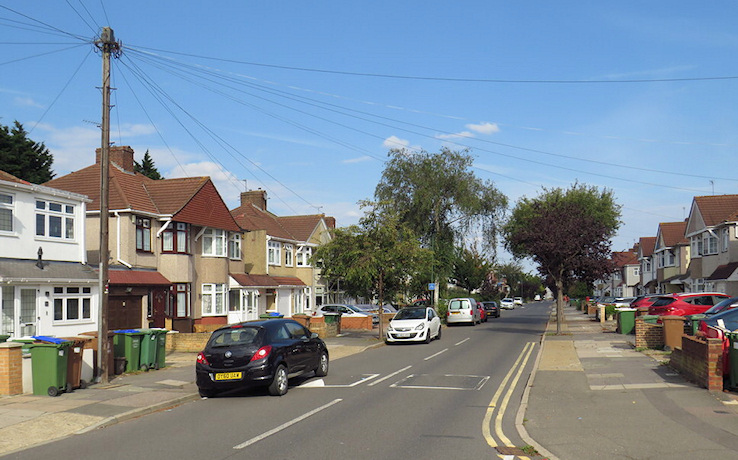Falconwood
Falconwood, Bexley/Greenwich
A privately developed, (originally) low-cost estate, separated from Eltham Park by Oxleas Wood and Shepherdleas Wood

Falcon Wood was part of Eltham Palace’s extensive parkland from medieval times, and its name was said to have derived from the Plantagenet kings flying their falcons here. After the Civil War the trees were felled for use in shipbuilding. From 1867 until 1955 a mansion named Falconwood stood on the east slope of Shooters Hill.
Until the late 19th century most of the present settlement of Falconwood was covered by West Wood, which was owned by Oxford University, lords of the manor of Bexley. This woodland was cleared in 1895 and replaced by Westwood Farm.
In the early 1930s the farm was acquired by New Ideal Homesteads (NIH), south-east London’s pre-eminent suburban housebuilders, for the creation of a south-westward extension of Welling. Although it would obviously have been more correct to call the development ‘Westwood’, NIH must have wanted something more distinctive. They originally went for ‘Falconwood Park’ (they rarely built an estate without appending the word ‘Park’ to its name), but the suffix didn’t stick.
NIH erected over 2,000 properties at a total construction cost of £1.5 million, offering detached houses with two reception rooms, three bedrooms, a bathroom and a separate lavatory from an economical £559. Wimpey and Wates also built some homes in the vicinity.
The mock-Tudor shops and amenities of the Green covered the site of Westwood farmhouse. NIH contributed substantially to the cost of the ‘functional and fashionable’ station, which opened long after the rest of the Bexleyheath line, on New Year’s Day in 1936. The booking office’s art deco architecture no longer looks very pleasing – but it still could, if some thought and funding were invested in its restoration.
Falconwood Field was acquired as a public open space in 1936. At the western end of Lingfield Crescent, across from the station, the Falcon pub is now a Harvester restaurant.
Eltham Cemetery (also known as Falconwood Cemetery) opened in 1935 and a crematorium was added in 1956, as was a remembrance chapel said to have been designed as a tiny replica of Liverpool Cathedral. (It’s a mystery to Hidden London which Liverpool cathedral this might have been.) A series of memorial courts were opened in 1996.
Westwood infant, junior and secondary schools were established around the same time as the first homes were built. The infant and junior schools have since become Bishop Ridley Church of England primary school while the secondary school is now the Harris Academy Falconwood, which came into existence in 2009 and moved into new buildings in 2011.
Falconwood community centre was opened in 1954. Four years later, Bishop Ridley church was completed. The church, which is small but with an airy interior, is located on the other side of Falconwood Parade from the community centre.
In Bexley’s Falconwood and Welling ward, 88% of homes are owner-occupied. Although the number of black and Asian residents almost tripled between 2001 and 2011, this increase was from a small base. The overwhelming majority of residents are still white British.
Postal district/postcode area: SE9 and Welling DA16
Population: 10,800 (Bexley’s Falconwood and Welling ward)
Station: Southeastern (zone 4)
